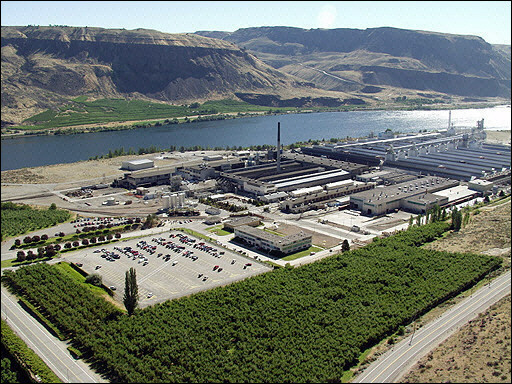forum
library
tutorial
contact

Wash. Alcoa Plant, 1 of just 2 Remaining
Aluminum Smelters in Northwest, Celebrates 60 Years
by Shannon Dininny
The Republic, June 22, 2012
|
the film forum library tutorial contact |

|
Wash. Alcoa Plant, 1 of just 2 Remaining
by Shannon Dininny
|
The Pacific NW aluminum industry supplied roughly 40 percent of the nation's aluminum in its heyday in the 1980s,
with 10 plants producing the pliable, lightweight metal for everything from war planes to soda cans.
 The Pacific Northwest aluminum industry supplied roughly 40 percent of the nation's aluminum in its heyday in the 1980s, with 10 plants producing the pliable, lightweight metal for everything from war planes to soda cans.
The Pacific Northwest aluminum industry supplied roughly 40 percent of the nation's aluminum in its heyday in the 1980s, with 10 plants producing the pliable, lightweight metal for everything from war planes to soda cans.
Today, just two plants remain -- but one of them celebrates its 60th anniversary Saturday with an open house and an idle plant in Montana is considering a restart thanks in part to abundant power supplies.
Aluminum smelters were the first major industrial customers of the hydropower dams built on the Columbia River during and after World War II, and at one time, consumed enough power to light three cities the size of Seattle. In the past decade, though, rising power and labor costs and global market competition forced most plants in the region to close.
The two that remain: Alcoa's Intalco Works in Ferndale, Wash., north of Bellingham in the northwest corner of the state, and Alcoa's Wenatchee Works in north-central Washington.
Since Wenatchee Works opened in 1952 -- the first smelter built in the Pacific Northwest after World War II -- it has been one of that area's largest private employers, with a high of 1,000 workers in the 1980s.
Today, the plant employs 450 people, but creates an additional 2.9 jobs in the surrounding area for every job at the plant and contributes $52 million to the economy directly through wages and benefits, said Alcoa's Sharon Kanareff.
Alcoa is offering free plant tours Saturday to celebrate the 60th anniversary.
"We're honoring a lot of our partners at the event, because really, we wouldn't be able to be here without our business partners -- our customers, our suppliers, our community support," Kanareff said.
U.S. primary aluminum production totaled nearly 2 million metric tons in 2011, an increase of 15 percent from the previous year, according to surveys by The Aluminum Association, a promotional group based in Arlington, Va.
Primary aluminum is product that has not yet been recycled.
U.S. producers also have the infrastructure to recycle aluminum, which requires only 5 percent of the power needed to produce primary aluminum, association President Heidi Block said. And low-cost power availability and future demand for certain products are likely to fuel aluminum production in the coming years.
Demand for aluminum by the automotive sector is expected to double by 2025, along with consumer interest in more fuel-efficient, lightweight vehicles, she said. Companies looking for sustainable packaging and "green" building supplies also are expected to boost demand.
In Columbia Falls, Mont., an idle plant is considering a restart, according to the Bonneville Power Administration, the Portland, Ore.-based federal agency that manages much of the Northwest power grid.
Columbia Falls Aluminum, located near the Hungry Horse Dam in northwest Montana, laid off nearly 90 workers when it closed at the end of October 2009.
BPA has told the company it can provide 140 average megawatts of power each year, spokesman Michael Hansen said, which is roughly enough power for two pot lines to operate.
learn more on topics covered in the film
see the video
read the script
learn the songs
discussion forum
